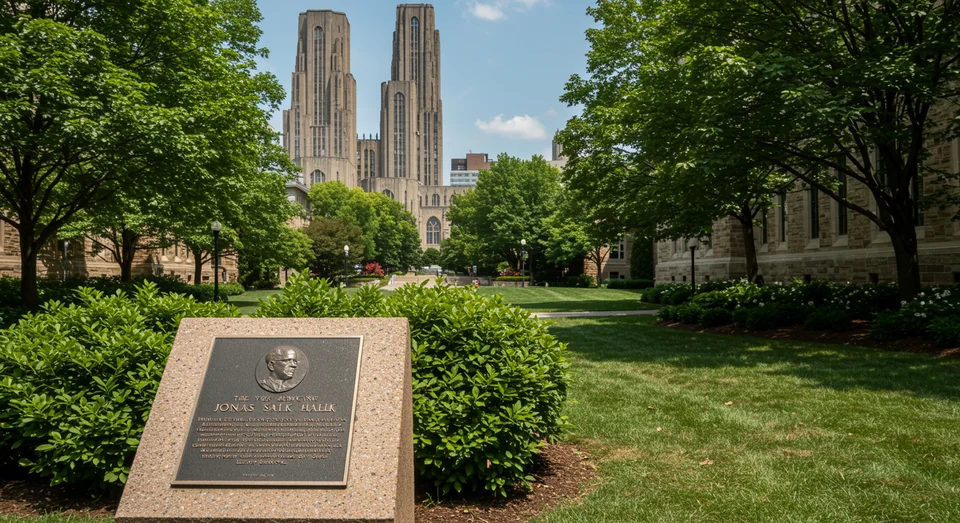Jonas Salk and University of Pittsburghs Polio Vaccine: A 70-Year Legacy of Hope
37 views
Seventy years ago, on April 12, 1955, the world held its breath as Dr. Thomas Francis Jr. announced to a crowd of scientists, reporters, and public health officials that Jonas Salk's polio vaccine had passed the ultimate test: it was "safe, effective, and potent." This declaration marked a seismic shift in the battle against a virus that had haunted generations, leaving paralysis and death in its wake. It was a moment that not only changed the trajectory of public health but also underscored the profound impact of scientific ingenuity and collective will.
The Legacy of Jonas Salk's Vaccine: A Triumph Over Polio and Fear
The story of the polio vaccine is one of determination, innovation, and a society united by urgency. In the early 20th century, polio was a specter that loomed large, particularly during the summer months when outbreaks surged. Children were its most frequent victims, with thousands succumbing to paralysis or confined to "iron lungs," the mechanical respirators that kept them alive when their muscles failed. By the early 1950s, the United States was grappling with an annual toll of 45,000 cases, a figure that represented not just a medical crisis but also a collective dread woven into the fabric of daily life.

Jonas Salk, a virologist working at the University of Pittsburgh, emerged as the unlikely hero of this narrative. Unlike some of his contemporaries, Salk pursued a vaccine using an inactivated virus, a bold departure from the live-virus approach that carried greater risks. His methodology was as meticulous as it was daring; before testing the vaccine on others, he injected himself, his wife, and his children, a gesture that spoke volumes about his confidence in its safety.
The pivotal moment came in 1954, when the vaccine was administered to nearly 1.8 million children, dubbed the "Polio Pioneers." Their participation in what was then the largest clinical trial in history was a testament to the desperation and hope of parents who saw no other way to protect their children. When the results were unveiled the following year, showing over 90% effectiveness with minimal side effects, the world exhaled in relief.
The vaccine's rollout was swift and decisive. Schools, community centers, and public health clinics became vaccination hubs as the government mobilized resources to ensure widespread access. By 1962, just seven years after its introduction, annual polio cases in the United States had plummeted to 910—a staggering decline that highlighted the vaccine's transformative power. The ripple effect was global, with countries around the world adopting the vaccine and setting the stage for the eventual eradication of polio in most regions.
This milestone anniversary invites reflection not only on the scientific achievement but also on the societal dynamics that made it possible. The polio vaccine's success was a convergence of factors: Salk's brilliance, the trust of millions of parents, and a government willing to act swiftly in the face of a public health emergency. It was also a moment that redefined the relationship between science and the public. Salk famously refused to patent the vaccine, stating that it belonged to the people, a gesture that underscored his commitment to humanity over profit.
Yet, the road to this triumph was not without its challenges. The Cutter Incident of 1955, in which a batch of improperly inactivated vaccines caused 40,000 cases of polio, was a sobering reminder of the stakes involved. It prompted stricter regulations and quality controls, lessons that resonate in today's vaccine development and distribution efforts.
The legacy of Salk's vaccine extends far beyond the eradication of a single disease. It galvanized a generation of scientists and public health officials, inspiring advancements in virology, immunology, and vaccine technology. It also laid the groundwork for the global vaccination campaigns that have since tackled diseases like measles, smallpox, and, most recently, COVID-19. The parallels between the polio epidemic and the coronavirus pandemic are striking, from the initial fear and uncertainty to the eventual triumph of science. Both crises illuminated the importance of public trust, equitable access, and international cooperation in overcoming health challenges.
As we commemorate this 70th anniversary, it is worth considering the broader implications of Salk's work. The fight against polio was not just a medical battle but a societal one, requiring the alignment of science, policy, and public will. It was a reminder that progress is possible when collective action is driven by a shared sense of purpose. Today, as the world grapples with new and evolving health threats, the lessons of the polio vaccine remain as relevant as ever.
In the end, the story of Jonas Salk and his vaccine is a testament to what humanity can achieve when it chooses hope over fear, action over inertia. It is a story that continues to inspire, reminding us that even in our darkest hours, the light of discovery can guide us toward a better, healthier future.